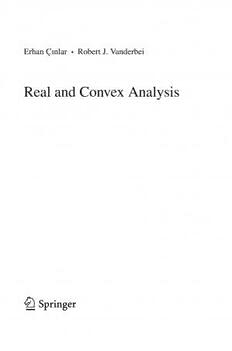Table Of ContentUndergraduate Texts in Mathematics
Undergraduate Texts in Mathematics
SeriesEditors:
SheldonAxler
SanFranciscoStateUniversity,SanFrancisco,CA,USA
KennethRibet
UniversityofCalifornia,Berkeley,CA,USA
AdvisoryBoard:
ColinC.Adams,WilliamsCollege,Williamstown,MA,USA
AlejandroAdem,UniversityofBritishColumbia,Vancouver,BC,Canada
RuthCharney,BrandeisUniversity,Waltham,MA,USA
IreneM.Gamba,TheUniversityofTexasatAustin,Austin,TX,USA
RogerE.Howe,YaleUniversity,NewHaven,CT,USA
DavidJerison,MassachusettsInstituteofTechnology,Cambridge,MA,USA
JeffreyC.Lagarias,UniversityofMichigan,AnnArbor,MI,USA
JillPipher,BrownUniversity,Providence,RI,USA
FadilSantosa,UniversityofMinnesota,Minneapolis,MN,USA
AmieWilkinson,UniversityofChicago,Chicago,IL,USA
UndergraduateTextsinMathematicsaregenerallyaimedatthird-andfourth-year
undergraduatemathematicsstudentsatNorthAmericanuniversities.Thesetextsstrive
to provide students and teachers with new perspectives and novel approaches. The
books include motivation that guides the reader to an appreciation of interrelations
amongdifferentaspectsofthesubject. Theyfeatureexamplesthatillustratekeycon-
ceptsaswellasexercisesthatstrengthenunderstanding.
Forfurthervolumes:
http://www.springer.com/series/666
Erhan C¸ınlar Robert J. Vanderbei
•
Real and Convex Analysis
123
ErhanC¸ınlar RobertJ.Vanderbei
DepartmentofOperationsResearch DepartmentofOperationsResearch
andFinancialEngineering andFinancialEngineering
PrincetonUniversity PrincetonUniversity
Princeton,NewJersey Princeton,NewJersey
USA USA
ISSN0172-6056
ISBN978-1-4614-5256-0 ISBN978-1-4614-5257-7(ebook)
DOI10.1007/978-1-4614-5257-7
SpringerNewYorkHeidelbergDordrechtLondon
LibraryofCongressControlNumber:2012950352
MathematicsSubjectClassification:MSC2010:97110,26-01,28-01,34-01,40-01,49-01,52-01
c SpringerScience+BusinessMediaNewYork2013
⃝
Thisworkissubjecttocopyright. AllrightsarereservedbythePublisher, whetherthewholeorpartof
thematerialisconcerned,specificallytherightsoftranslation,reprinting,reuseofillustrations,recitation,
broadcasting, reproduction onmicrofilms orinanyotherphysical way, andtransmissionorinformation
storageandretrieval,electronicadaptation,computersoftware,orbysimilarordissimilarmethodologynow
knownorhereafterdeveloped. Exemptedfromthislegalreservationarebriefexcerptsinconnectionwith
reviewsorscholarlyanalysisormaterialsuppliedspecificallyforthepurposeofbeingenteredandexecuted
onacomputersystem,forexclusiveusebythepurchaserofthework. Duplicationofthispublicationor
partsthereofispermittedonlyundertheprovisionsoftheCopyrightLawofthePublisher’slocation,inits
currentversion,andpermissionforusemustalwaysbeobtainedfromSpringer.Permissionsforusemaybe
obtainedthroughRightsLinkattheCopyrightClearanceCenter. Violationsareliabletoprosecutionunder
therespectiveCopyrightLaw.
Theuseofgeneraldescriptivenames,registerednames,trademarks,servicemarks,etc. inthispublication
doesnotimply,evenintheabsenceofaspecificstatement,thatsuchnamesareexemptfromtherelevant
protectivelawsandregulationsandthereforefreeforgeneraluse.
Whiletheadviceandinformationinthisbookarebelievedtobetrueandaccurateatthedateofpublication,
neithertheauthorsnortheeditorsnorthepublishercanacceptanylegalresponsibility foranyerrorsor
omissionsthatmaybemade. Thepublishermakesnowarranty, express orimplied, withrespecttothe
materialcontainedherein.
Printedonacid-freepaper
SpringerispartofSpringerScience+BusinessMedia(www.springer.com)
Preface
This book is intended to serve as a first course in analysis for scientists and
engineers. It can be used either at the advanced undergraduate level or as part of
thecurriculuminagraduateprogram. Wehavetaughtfrompreliminarydraftsofthe
bookforseveralyears.
Thebookisbuiltaroundmetricspaces.Inthefirstthreechapters,welaythefoun-
dationalmaterial. Wecovertheall-important“fourCs”: convergence,completeness,
compactness,andcontinuity. We haveorganizedthe materialtobe assimpleandas
logicalaspossible.
In subsequent chapters, we use the basic tools of analysis to give a brief intro-
duction to closely related topics such as differential and integral equations, convex
analysis,andmeasuretheory.Thebookisshortandyetcoversinsomedepththemost
importantsubjects.Wegavecarefulconsiderationtowhattoincludeandwhattoleave
out. Inallsuchconsiderations,weaskedourselveswhetherthematerialwouldbeof
directandimmediateusetoscientistsandengineers. Ourphilosophyis“ifindoubt,
dowithout.”
Whatmakesthisbookdifferent? Wepulltogethersomeofthefoundationalma-
terialonemightfind,forexample,intheclassicbookbyRudin[Rud76]withmaterial
onconvexityandoptimizationatalevelcommensurate,say,withthebookbyBorwein
andLewis[BL06]andwithacompletelymoderntreatmentofthebasicsofmeasure
theory. Theimportanceofmeasuretheoryhasincreasedovertheyearsasstochastic
modeling has become more central to all aspects of analysis. Similarly, optimiza-
tionplaysaneverincreasingroleasonetriestodesignandanalyzethebestpossible
“widget.”
We hope that the reader will enjoy the book and learn some important mathe-
matics.
We would like to thank the many students whom we have had the pleasure of
teachingovertheyears.WegiveaspecialthankstoJohnD’Angelo;hecarefullyread
adraftofthemanuscriptandmadenumeroushelpfulsuggestions.
E.C¸ınlarandR.J.Vanderbei
v
Contents
Preface v
NotationandUsage ix
Chapter1. SetsandFunctions 1
A. Sets 1
B. FunctionsandSequences 4
C. Countability 6
D. OntheRealLine 9
E. Series 14
Chapter2. MetricSpaces 23
A. EuclideanSpaces 23
B. Metrics 25
C. OpenandClosedSets 29
D. Convergence 35
E. Completeness 37
F. Compactness 41
Chapter3. FunctionsonMetricSpaces 47
A. ContinuousMappings 47
B. CompactnessandUniformContinuity 52
C. SequencesofFunctions 56
D. SpacesofContinuousFunctions 59
Chapter4. DifferentialandIntegralEquations 65
A. ContractionMappings 65
B. SystemsofLinearEquations 70
C. IntegralEquations 73
D. DifferentialEquations 80
Chapter5. Convexity 85
A. ConvexSetsandConvexFunctions 85
B. Projections 88
vii
viii Contents
C. SupportingHyperplaneTheorem 91
D. LegendreTransform 92
E. InfimalConvolution 98
Chapter6. ConvexOptimization 101
A. PrimalandDualProblems 101
B. LinearProgrammingandPolyhedra 106
C. Lagrangians 108
D. SaddlePoints 109
Chapter7. MeasureandIntegration 115
A. Algebras 115
B. MeasurableSpacesandFunctions 118
C. Measures 125
D. Integration 131
E. TransformsandIndefiniteIntegrals 141
F. KernelsandProductSpaces 146
FurtherReading 155
Bibliography 157
Index 159
Notation and Usage
We use the terms “positive” and “negative”in their wide sense: positive means
0, negative means 0. Similarly, “increasing” means x y implies f(x)
≥ ≤ ≤ ≤
f(y). Ifstrictinequalitieshold,wesay“strictlypositive,”“strictlynegative,”“strictly
increasing,”etc. Hereisalistoffrequentlyusednotations.
:Theemptyset.
∅
N= 0,1,2,... :Thesetofnaturalnumbers.
{ }
N∗ = 1,2,3,... :Thesetofstrictlypositiveintegers.
{ }
Z= 0,1, 1,2, 2,... :Thesetofintegers.
{ − − }
Q={x : x= mn forsomeminZandsomeninN∗}:Thesetofrationals.
R=( , )= x: <x<+ :Thesetofreals.
−∞ ∞ { −∞ ∞}
R+ =[0, )= x R:x 0 :Thesetofpositivereals.
∞ { ∈ ≥ }
R∗ =( , ]: Thesetofrealsandplusinfinity.
R¯ =[ −∞, ∞]: Thesetofextendedreals.
−∞ ∞
[a,b]= x R:a x b :Theclosedintervalwithendpointsaandb.
{ ∈ ≤ ≤ }
(a,b)= x R:a<x<b :Theopenintervalwithendpointsaandb.
{ ∈ }
log(x): Thenaturallogarithmofx.
x y = nx y : Theinnerproductofxandy.
· 1 i i
x =√x x: TheEuclideannormofx.
∥ ∥ ! ·
:Thesetofcontinuousfunctions.
C
d(x,y): Thedistancefromxtoy.
B(x,r)= y :d(x,y)<r : Theopenballcenteredonxofradiusr.
{ }
A : TheinteriorofthesetA.
◦
A¯: TheclosureofthesetA.
∂A:TheboundaryofthesetA.
fˆ: TheLegendretransformofthefunctionf.
f⋆g :Theinfimalconvolutionofthefunctionsf andg.
x y: Theminimumoftherealnumbersxandy.
∧
x y: Themaximumoftherealnumbersxandy.
∨
1 : TheindicatorfunctionofthesetA.
A
(E):TheBorelσ-algebraonthemetricspaceE.
B
ix

